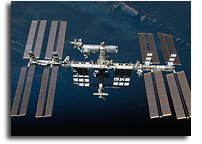Summary of the ISS National Laboratory CAN (not so) “Public Day”

NASA held a “public day” for the recently-released Cooperative Agreement Notice (CAN) for the ISS National Lab Management Entity at NASA Headquarters today. Didn’t now about it? You’re not alone.
The audience at this barely publicized event was a hundred or so people – mostly 40-50+ year old white males. With the exception of one guy who walked up and said hello to me after the meeting I could see no representatives of (or apparently for) for the next generation of space explorers. Apparently ISS utilization and the next generation of potential users is not seen as a priority with the folks at SOMD (Space Operations Mission Directorate) otherwise they’d have found a way to get broader participation – including the folks that will be using this facility in a decade or so.
An easy way to make certain that you get the broadest, most representative audience of prospective users is to announce the event where people will see the announcement and then put things on NASA TV and the web. Or at a minimum, record it for later dissemination. Alas, that is obviously beyond the interests or capabilities of SOMD. Despite all of NASA’s supposed social media prowess not a single person at SOMD could manage to send a tweet from/about this meeting. @NASA has 698,739 followers yet there was not a single tweet or mention of this event. I am almost certain I was the only one in the meeting who was Twittering and telling non-attendees what was going on. The official Twitter @ISS_NatLab certainly carries no details or commentary from the meeting.
There is no mention of this meeting on the calendar at NASA.gov or any mention on the SOMD home page. Indeed, they do not even mention this event (upcoming or otherwise) on the official ISS National Laboratory home page.
Small wonder attendance was so low. SOMD clearly did the minimal effort required to jump through the required hoops. No imagination required – none shown.
In the formal procurement announcement for this meeting, NASA said “Only parties that have registered will be permitted to attend. No walk-in participants will be accepted.” Well, when I arrived there was no registration desk. No one asked if I or anyone else was registered. As I left the meeting several people told me that they had just walked in and sat down without registering. When NASA finally got around to issuing a press release on 2 December 2010 (the way that the media and the public find out about such things), potential attendees only had 28 hours to register. Talk about short notice.
Think of all the people who might have attended – physically or virtually – had SOMD spent some effort making this event known – and accessible.
As for the plan within the CAN itself, it would seem that all NASA wants to do is recreate its own ISS managerial dysfunctionality with a new layer of bureaucracy to confuse things further. NASA only wants to let the winner have a one year contract with each annual renewal based on the past year’s performance. Sounds nice in practice, but one would think that this would limit the amount of investment any proposer would want to put on the table. NASA seems to be uninterested in taking any risk while the proposers are asked to shoulder it all.
In addition, NASA ropes off some of the most interesting stuff (human space physiology and spacecraft testing and engineering) as being off limits to proposers. Anyone proposing to do this will be considered “non-responsive”. Oddly, these are two of the most promising uses of the ISS – the sorts of things that a lot of people would like to use the ISS for. In the CAN, NASA talks of transferring new research responsibility to the contractor but is vague as to what they actually mean by this or at what pace that would happen. Again, how do you plan for such things?
SOMD’s Mark Uhran urged attendees not to base their thinking on the way things were with space station research 15 years ago. Well, based on the way NASA has put this CAN together, little seems to have changed in the past 15 years. The process is still ponderous and is not remotely user friendly unless you’ve spent years becoming versed in the Byzantine processes that NASA throws at you. NASA does not really want to “let go” of the control it has over how the ISS is to be used. So it is probably prudent for proposers to assume that NASA is not about to change its behavior in any meaningful way – and they should lower their expectations accordingly.
All in all NASA still seems to be confused as to what it wants to do with this truly marvelous resource – one that could serve as a base camp for the exploration and utilization of the solar system – if only NASA would set it free, so to speak. NASA has had two decades to figure this out. While the agency goes through the motions (which only truly materialized due to Congressional mandate) to look like it is trying to attract new users all it really wants to do is keep all the interesting stuff to itself with only gratuitous crumbs thrown to prospective new users.
In summary: Its the same wonderfully capable, yet under-utilized space station burdened with the same flawed and closed thinking that NASA never seems to be willing – or able – to escape.
Related Links
“As far as I can tell, NASA never issued a press release about this report. With all the talk of human spaceflight and commercialization, one would think that an attempt to frame the future uses of the ISS would be of broad interest. Guess not.”
Reference Model for the International Space Station, U.S. National Laboratory








